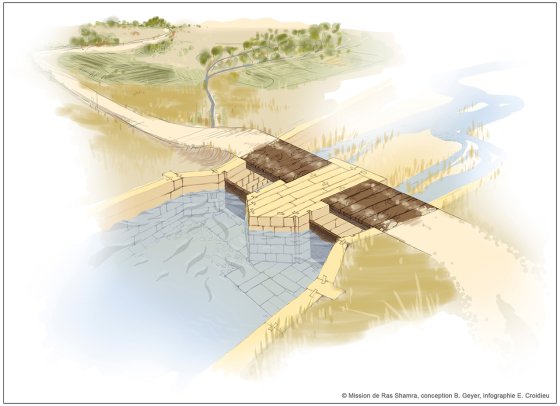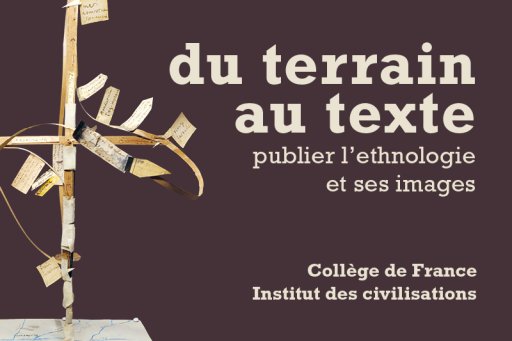
During the Bronze Age, the city of Ugarit developed an ingenious water management system. As part of the " Les politiques de l'eau au Proche-Orient, de Sumer à nos jours "program, supported by Avenir Commun Durable, Valérie Matoïan and her team compare this ancient organization with the region's current characteristics.
We are in the 2nd millennium BC. The city of Ugarit, located in present-day Ras Shamra in Syria, was the capital of a kingdom - -that bore the same name. Very early in human history, this society impressed by its organization. Following in the footsteps of the Hittite Empire, Ugarit was a medium-sized but highly structured political power, with a king, queen, prefect and central administration. The kingdom was an economic power of the first order : its commercial activity took place both overland and by sea, thanks to ports located not far from the capital. It was home to numerous professional guilds, working in stone, wood, textiles, ceramics, armaments, etc. In this city of between seven thousand and ten thousand souls, according to estimates, there were several writing systems, a polytheistic religion, social classes and traditions such as marriage, divorce, adoption and inheritance... For almost one hundred years, the kingdom has fascinated the members of the Syrian-French archaeological mission at Ras Shamra-Ougarit. Valérie Matoïan, who co-directs the mission with Khozama Al-Bahloul, is currently studying the question of water management in this region. Over a period of three years, as part of the Avenir Commun Durable program, the CNRS research director (UMR 7192 Proclac) and her team will be comparing the landscape andwater-related developmentsof Ugarit's past with those of today. It's an ambitious project, made possible by the comparison of numerous sources and the alliance of several scientific disciplines.
Research since 1929
In 1928, while ploughing his field in the Ras Shamra region, a farmer made a strange discovery. " He discovered by chance a tomb built of cut stone, containing funerary furniture," recounts Valérie Matoïan. The objects were then appraised by René Dussaud, curator of the Oriental Antiquities Department of the Louvre Museum, who dated them to the end of the 2nd millennium BC. They testify to relations between the Syrian coast and the island of Cyprus, making this a major discovery. "René Dussaud therefore invited France to carry out excavations in the area, which began the following year under the direction of archaeologist Claude Schaeffer : twohundred or even three hundred workers were employed during these campaigns, enabling major excavations to be carried out. He led the excavations until the end of the 1960s, succeeded by several archaeologists continuing the mission - which became Syro-French in 1999. "Excavations have shown that the site was occupied as early as the Neolithic period and continuously until the end of the Bronze Age, around 1200 BC", explains Valérie Matoïan. But the best-documented period corresponds to the years 1350-1180 BC, i.e. the end of the history of Ugarit, before its destruction. Archaeological and textual documentation is extremely rich, with tens of thousands of objects found.
Many water-related discoveries
Among the many discoveries made on the site, a number of water management systems were uncovered. In particular, numerous wells were found in the city. Dug into the rock to access the water table and built on the surface, they bear a striking resemblance to modern-day wells. In some houses, there are also large stone tubs," adds the archaeologist. They are often found next to wells. We can speculate that they were used to store water. Or perhaps to wash dishes... " The town also boasted an impressive network of drains to evacuate rainwater and wastewater. " Two types of pipeshave been found: some made of stone, which was often covered by floors, and others made of terracotta. The latter were fitted into one another, along walls or in corners of rooms, for example, and were used to drain off overflowing water from terraces ", explains Valérie Matoïan. In addition, there was a sewage collection system, as well as cesspools for waste water, both inside and outside the houses. Among the most exceptional discoveries was a pleasure pool inside the royal palace : shallow, it was designed to receive water from a well via a pipe, thanks to an adduction system.
Outside the city, archaeologists have discovered a stone dam-bridge, one of the oldest testimonies of this type found anywhere in the world. By closing the gates, it created a small reservoir of water. This resource was used to supply the town in times of need. A pipe discovered at the dam is the subject of several hypotheses. Perhaps it was used to evacuate the overflow of water when the dam was closed by the sluice gates, and to irrigate nearby fields. One thing is certain : all these elements attest to the city's excellent water management.
Linking past and present
" For the period of Ugarit, the aim will be to draw up as complete an inventory as possible of all these water-related installations, something that has never been done before ", explains Valérie Matoïan. The aim ? To calculate the water requirements of a Mediterranean city in the Bronze Age. " It will also help us understand how the city functioned at a time when it was highly efficient. This will give us food for thought for other eras ", she adds. Making the link between past and present is indeed the watchword of the project. To do this, the researchers are working on several types of source : objects mainly preserved in museums in Syria and France, but also the Claude Schaeffer collection, entrusted to the Collège de France after his death in 1982. It includes a large collection of prints and casts of objects, as well as excavation archives : notebooks, inventory books, plans, sketches, photographs..
According to the researchers, the study of the contemporary period can also be fruitful :" It offers much more data and could perhaps help us to interpret the remains of the past, to better understand or evaluate them ", explains Valérie Matoïan. The project is therefore also focused on a study of the territory over the last hundred years. To understand recent changes in the landscape, geographers Nicolas Jacob-Rousseau and Bernard Geyer will study aerial photographs taken by the Levant army in the years 1930, as well as satellite images for more recent periods. They will observe the evolution of vegetation cover and hydrographic networks. To understand the evolution of the climate, the team has called on climatologist Myriam Traboulsi, a specialist in the region. She has begun her study, which may enable us to make projections for the future.
An area that remains (almost) the same ?
Although the project has only just begun, some interesting data have already been gathered. As far as the characteristics of the area are concerned, there has been some continuity since the Bronze Age. The Ugarit site is surrounded by two readings, three springs, and benefits from an accessible water table. In addition, the Ras Shamra region receives a lot of rainwater. In Latakia, the town just a few kilometers from Ugarit, rainfall is around 700 millimetres a year. This is explained by its geographical location : the mountains located a little further inland stop the clouds. " Unlike other regions of the Near East, irrigation of crops is not essential. Valérie Matoïan points out that"these favourable conditions made it easy to grow shrub crops, including olive groves, orchards, vines and cereals . The Mediterranean trilogy - vines, olive trees, wheat - found at the time of Ugarit can still be found today in this region ". So there is a certain unity over the millennia. But according to the archaeologist, there have been a number of developments on the Syrian coast. The area is much more densely populated, with more buildings. There has been an increase in orchards, particularly for orange and lemon trees, which didn't occupy such a large area in the past. This is accompanied by deforestation. Forests were already being exploited in ancient times, but they were far more abundant than they are today. And the water sources that were used by the peasants of Ugarit's time are still used today, but to a completely different extent : the use of electric pumps leads to much greater withdrawals, thus overexploiting the water table ! The creation of numerous dams has also changed the landscape.
Climate over the millennia
The region's Mediterranean climate seems to have survived the test of time. Characterized by wet winters and dry summers, it is broadly the same today as it was in the days of Ugarit. " Religious and mythological texts from Ugarit allude to this climate. While it is very favorable to man, there are also periods of irregularity and drought. One text, for example, records seven years without rain, leading to aridity and damaging crops. This irregularity is still with us today ", explains Valérie Matoïan. Some sediment cores taken in the region also testify to a drought phase at the end of the Bronze Age. According to the archaeologist, this period was marked by the destruction of several civilizations : Hittite, Mycenaean, Ugaritic... " The causes of this destruction have been investigated for decades.One of them could have been the drought, which handicapped these societies, perhaps causing famines... " Thoughts still at the hypothesis stage.
As far as the contemporary period is concerned, the initial results of climatologist Myriam Traboulsi seem to indicate a trend: a decrease in rainfall. But it remains to be seen whether this trend towards more drought is maintained, and whether it can be seen over the longer term," explains Valérie Matoïan. This long-term work is only just beginning. Avenir Commun Durable is a tremendous support for this stage of our research. It also enables us to welcome and train young researchers, which is very important to us ".
Article by Salomé Tissolong






